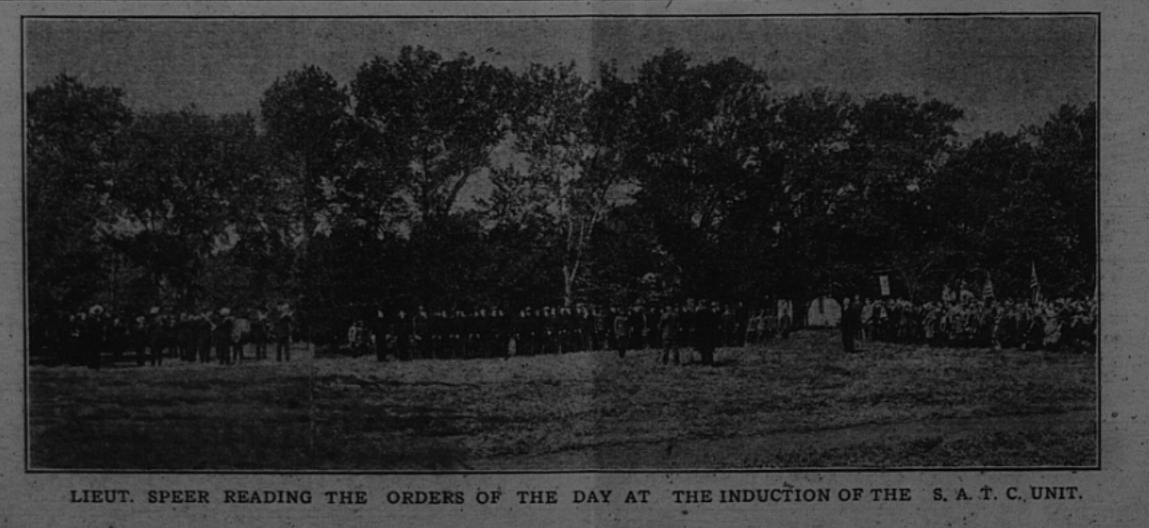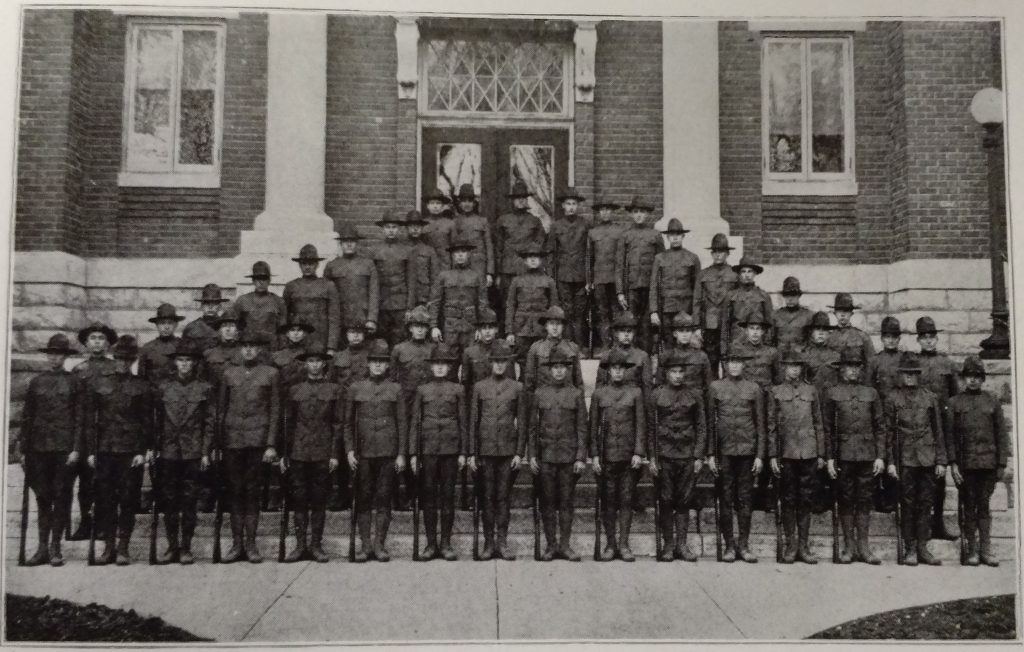During this time, Bethany College had a chapter of the Student Army Training Corps, or SATC. This encouraged young men around the country to pursue an education while serving their country. The SATC was a voluntary program that inducted 200,000 men on its first day. These men were given private status, which gave them no way to avoid enlistment.[1]
The SATC was formed by Congress as part of the Selective Service Act of 1917. It’s purpose, according to the SATC Training Manual, was to utilize effectively the plant, equipment, and organization of the colleges for selecting and training officer candidates and technical experts for service in the existing emergency. The Institutional Requirements for SATC were as follows:[2]
- Requires for admission to its regular curricula graduation from a standard, four-year, secondary school, or an equivalent, and
- Ordinarily provides a general or professional curriculum covering at least 2 years of not less than 32 weeks each, and
- Has a student attendance sufficient to maintain a collegiate section of a Students’ Army Training Crops unit with a strength of at least 100 men.[3]
Applications were accepted from smaller schools to create sections of men as long as the government believed they would be able to provide quality men capable of performing well within their means. Bethany College was one of these schools. They were required to have at least 50 men to become an active unit.
If a unit of men did not meet the standards, they would be discontinued.
Caption: Lieut. Speer Reading the Orders of the Day at the Induction of the SATC Unit
Here is an excerpt from an article in the October 12, 1918 Bethany Messenger:
“Bethany has to date 44 accepted and physically fit men in the S. A. T. C. Unit. There must be 50 such men in the unit by Oct. 20. If fifty men of required standards are not inducted by that date one of two things will result. Either Bethany’s unit will be transferred to some other school or the unfilled unit of someother school will be transferred here. Fifteen High School credits or its equivalent is prerequisite to enter.”
The Messenger then calls for students to dig deep down to help their Alma Mater. They remind the students that members of the SATC receive government benefits and are doing their country a disservice by not joining.[4]
While the school called for their men to rise up in the face of war, here is an interesting piece from The Daisy 1919, Bethany’s yearbook that shows not everyone from the college was sure about the formation of the unit:
“The Student Army Training Crops, probably the most peculiar innovation ever introduced into the college life of Bethany, is now a part of her history. This attempt on the part of the Government to create, as it were, military schools out of institutions hitherto strictly academic, has been variously characterized. It has been called a spurious, inefficient effort to socialize America’s educational institutions and has received perhaps the more than its share of adverse comment. But judging from the effects of its brief stay at our own college it cannot be said that its work was altogether in vain nor its consequences entirely evil. We neither condemn nor fulsomely praise.”
It seems that the student body as a whole was split on its support of Bethany’s SATC unit. The yearbook later goes on to praise its commanding officers and the bravery of the men willing to fight for their country. They expressed their thankfulness that Bethany’s men were not needed overseas although contagious disease was rampant for a period of time, but did not take the lives of any soldiers. The school seems to be prideful of the brave men who were offering their lives for their country, but skeptical of the Government’s intentions.[5]
Seen below: Bethany’s SATC, which reached 52 men. (Click here for the full list of Bethany SATC members.)
___________________________________________________
[1] Wikipedia. Reserve Officers’ Training Corps. December 7, 2016. https://en.wikipedia.org/wiki/Reserve_Officers’_Training_Corps#Student_Army_Training_Corps_.28SATC.29 (accessed December 4, 2016).
[2] U.S. Government. “Student’s Army Training Corps Regulations.” United States National Archives. September 24, 1918. https://ia902707.us.archive.org/7/items/studentsarmytrai00unit/studentsarmytrai00unit.pdf (accessed December 8, 2016).
[3] Ibid.
[4] Bethany College Messenger, October 12, 1918.
[5] Bethany College Yearbook “The Daisy”, 1919.


